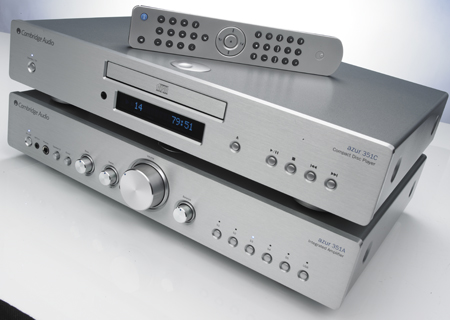What Hi-Fi? Verdict
A good effort: worth considering if you prefer an overtly energetic approach to music replay
Pros
- +
A clear and informative sound
- +
built-in DAC
- +
plenty of attack
- +
pleasing build and finish
Cons
- -
Lacks a little finesse
- -
treble could be more refined
- -
no optical input
Why you can trust What Hi-Fi?

Which company makes the best budget hi-fi separates? The answer to that question has been surprisingly easy over the last few years, and it’s not one to make Cambridge happy.
In our opinion it’s Marantz that’s king of budget stereo kit, and it has been for a while. That company’s 6004 series CD player and PM6004 amplifier set the standards below the £500 mark thanks to their fluid, refined yet entertaining sound. Their fine build quality and a comprehensive feature list doesn’t hurt either.
The task facing Cambridge’s Azur 351 components is a daunting one, but first impressions are good.
Cambridge Audio 351A: Build quality
The Cambridge Audio 351A is a solidly built integrated unit that belies its price tag when it comes to finish and appearance. Those well-crafted front panel controls all feel solid and precise to the touch. Its Marantz rival – the PM6004 – feels a little insubstantial and plasticky in comparison.
It never ceases to surprise us how well specified budget amplifiers are compared to their pricier counterparts. Products at high price levels tend to throw out features to benefit sound. Budget products tend to cram-in everything from headphone sockets to speaker switching while still trying to perform well, and that’s the case here.

Cambridge Audio 351A: Tech specs
While the built-in phono stage is a thing of the past as far as 351A is concerned – Cambridge makes fine, affordable outboard units if you need one – it still boasts a generous specification including five line level inputs, subtle-acting tone controls and remote operation.
The 351A pulls ahead of its rivals by also featuring a built-in digital-to-analogue converter. Input to the DAC is limited to USB-only, which is a shame as an optical option would have been useful.
Still, if you have music stored on a computer then it’s an option worth taking up. The input signal is limited to a sampling rate of 48kHz, which means that 16bit/44kHz CD rips will be accommodated, and for most people that will be enough.
If high resolution material replay is important to you it would be better to use better quality dedicated outboard units such as Arcam’s rPAC or AudioQuest’s DragonFly.
Cambridge Audio 351A: Power
Take a look inside the 351A and you’ll find neat circuit layouts, a motorised Alps volume controller and a reasonably hefty power supply.
The amplifier’s rated power output is 45 watts per channel, which is about par for the course. While that figure may not sound startling, it means this little amplifier can still drive most price compatible speakers to high levels in small to medium rooms.
Partner the 351A with suitable kit – we used the matching 351C CD player and the Marantz alternative together with Q Acoustic 2010is and Monitor Audio Bronze BX2s alongside our usual reference ATC SCM50s– and the results are good.

Cambridge Audio 351A: Sound quality
This is a clear and precise sounding amplifier that foregoes the overt warm and smoothness of its Marantz rival for clean and analytical balance.
As with most Cambridge products, this amplifier doesn’t hold back in the treble department, so avoid bright or aggressive sounding partnering equipment.
This is particularly true if you intend using the built-in DAC section, which sounds brighter and edgier than the line stages to our ears, even though it delivers greater clarity than our Apple MacBook used alone.
Partner sympathetically and the Azur 351A’s detail and punch will impress. Despite the ordinary power output this amplifier can kick hard when required. It has the dynamic reach to do justice to the likes of Tchaikovsky’s 1812 Overture, and can cope with musical complexity without degrading into a confused mess.
Move onto the likes of Jay Z’s Blueprint 3 set and this amplifier continues to impress with its low-end grip and agile nature. This is an upbeat and exciting amplifier, and if that sounds like something that appeals, jump right in.
Cambridge Audio 351A: Verdict
However, this amplifier falls short when it comes to conveying subtleties. Despite all its clarity this integrated isn’t expressive enough to deliver Nina Simone’s version of Here Comes The Sun with appropriate delicacy, nor does the 351A convey the spaciousness present in a recording of Arvo Part’s Litany with total conviction.
Put it altogether and this Cambridge integrated emerges as a good amplifier, but not one that satisfies across a wide range of recordings, and that’s enough to rob it of that fifth star.
What Hi-Fi?, founded in 1976, is the world's leading independent guide to buying and owning hi-fi and home entertainment products. Our comprehensive tests help you buy the very best for your money, with our advice sections giving you step-by-step information on how to get even more from your music and movies. Everything is tested by our dedicated team of in-house reviewers in our custom-built test rooms in London, Reading and Bath. Our coveted five-star rating and Awards are recognised all over the world as the ultimate seal of approval, so you can buy with absolute confidence.


